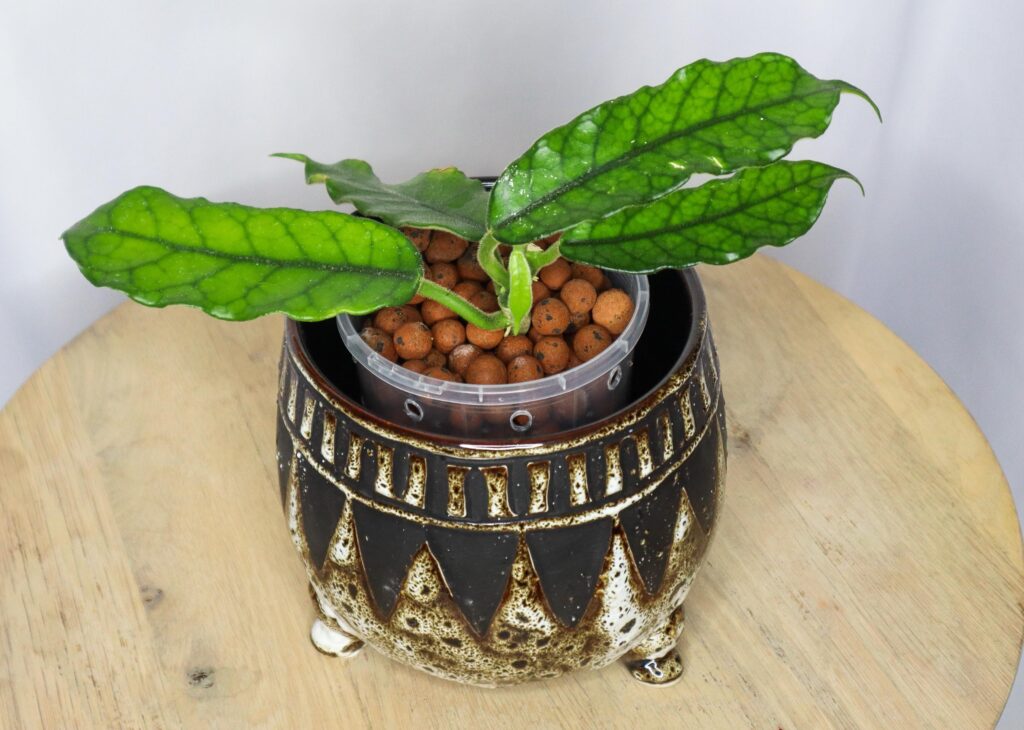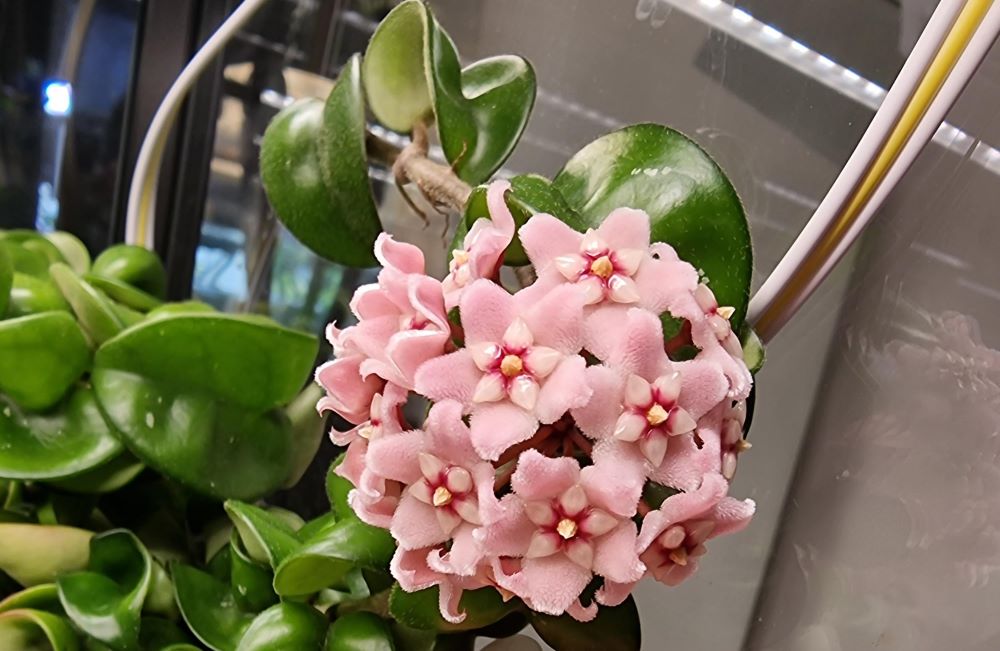I can’t wait to dive into the world of Hoyas and LECA with you! Hoyas hold a special place in my heart, and LECA is one of my go-to growing mediums for them.
Why? Because Hoyas are epiphytes, which means they naturally grow on trees. This unique trait makes their roots crave both water and oxygen, making LECA an ideal choice. Stay tuned for a detailed, step-by-step guide on setting up your Hoya cuttings for a thriving life in LECA.

Now, you might be wondering, “Do all Hoya varieties flourish in LECA?”
In my experience, I’ve yet to find a Hoya that didn’t love LECA. Sure, I’ve had a couple of setbacks, but let me clear the air—it wasn’t LECA’s fault. It was all about my approach.
So, don’t worry, I’ll share some foolproof tips for growing Hoyas successfully.
Transferring from Soil to LECA
I’ve experimented with various techniques when transitioning Hoyas to LECA, and let me tell you, the approach matters. From half-hearted root cleaning to meticulous scrubbing and even rerooting, I’ve tried it all.
Here’s what I found:
Partially Cleaned Roots
Avoid this method like the plague. Leaving bits of soil on the roots spells disaster. The roots get stressed out and often die off slowly.
Sure, you might get lucky and see a new root burst forth to save the day, but most of the time, it’s a losing battle. Your plant will likely just sit there, withering away over the course of 3-4 months.
Trust me, it’s not worth the risk.
Thoroughly Cleaned Roots:
This method fares better, particularly for Hoyas with fresh, young roots. While it’s an okay approach, you’ll still need to keep a close eye on your plant.
I’ve seen these roots fail as well, so vigilance is key.
Rerooting:
This is the gold standard, and here’s why. First, let’s be honest: cleaning Hoya roots isn’t the most enjoyable way to spend your time. Second, rerooting Hoyas is a breeze if you’ve got the right setup. I’ll delve into the specifics in an upcoming how-to guide.
So, if you’re looking for a foolproof way to transition your Hoyas to LECA, rerooting is the way to go.
Stay tuned for a step-by-step guide on how to do it right.
Pot Set-Up for Hoyas
Before diving in, make sure you’re familiar with the various pot configurations in the LECA world.
Starting with Rootless Cuttings
For cuttings that don’t have roots yet, I kick things off in a LECA propagation box. I let the roots grow to about an inch before moving on to the next step.
At this point, I usually opt for a non-wicking configuration until the roots start peeking out of the net-pot.
Once the roots are long and robust, I switch to a NSW (Nutrient Static Wick) configuration for long-term growth.
Short and Small Roots
When Hoya roots are tiny and fragile, they need a consistent moisture source to thrive. That’s where the non-wicking configuration comes in handy.
The LECA in this setup pulls up just enough water to keep the roots happy.
I’ve tried placing 1-2 inch roots directly into a NSW setup, but it didn’t go well. The top layer of LECA didn’t retain enough moisture, leading to plant failure.
So, to sum it up, if you’re transitioning Hoyas to LECA, the pot configuration you choose can make or break your success.
Start with a non-wicking setup for young roots and graduate to a NSW configuration for mature, long roots. Stay tuned for a detailed guide on how to get it right.
Hoya Long-Term Care: The NSW Method
When your Hoya roots stretch out to 3-5 inches and start venturing out of the pot, it’s time to switch to a NSW (Nutrient Static Wick) setup. Remember, Hoyas are epiphytes, so their roots crave a balanced mix of water and oxygen.
The Risk of Non-Wicking:
If you keep your Hoya in a non-wicking setup and consistently fill the reservoir without letting it dry, you’re setting the stage for root rot. Over time—think months or even a year—those submerged roots will start to decay.
Plus, removing rotten roots from a non-wicking setup can be a real hassle, often requiring a complete repot.
The Non-Wicking Alternative:
You could stick with a non-wicking setup if you’re willing to maintain a dry/wet cycle. This means letting the entire setup dry out for a few days before refilling the reservoir.
While I haven’t tried this approach, it could work if you’re diligent.
But honestly, I’m all about the NSW life.
Why NSW (Nutrient Static Wick) Works:
In a NSW setup, your roots are mostly underwater when the reservoir is full, soaking up all the hydration they need. As the water level drops, the roots get more exposure to air, maintaining that crucial balance.
The best part? You don’t have to wait for the reservoir to empty completely before refilling it. Your roots get an excellent mix of water and oxygen throughout the cycle. And if you spot any root rot, snipping off the affected parts is a breeze—no repotting needed.
So, for long-term Hoya care in LECA, I wholeheartedly recommend the NSW setup. It offers the perfect blend of water and oxygen, making it a win-win for both you and your plant.

Photo credits @TheLecaQueen
Hoya Fertilizing: Less Is More
Epiphytes like Hoyas are pretty low-maintenance when it comes to feeding.
In their natural habitat, they get by with whatever nutrients wash off from trees during rain showers.
Their roots are designed to absorb water and nutrients quickly, but they don’t need a lot to thrive.
My Go-To Fertilizer:
I treat my Hoyas much like my orchids when it comes to fertilizing. I’m a fan of the K-lite MSU formula, using it at a concentration of about 50-100ppm of Nitrogen per feeding session.
To put it in perspective, that’s only about half to a quarter of what I’d give to my Monsteras and Philodendrons.
So, if you’re looking to fertilize your Hoyas in LECA, remember that less is often more. A light feeding regimen is all they need to grow happily and healthily.
Temperature and Humidity
First things first, it’s crucial to know whether your Hoya is a warm, intermediate, or cool grower.
Trust me, you don’t want to make the mistake of placing a Polyneura in an 85-degree cabinet like I did once. Do your homework to provide the right temperature conditions.
While higher humidity can speed up growth, Hoyas don’t necessarily need high humidity levels to thrive in LECA.
Think of LECA as your plant’s personal pebble tray.
Watering
Here’s the deal—I don’t keep track of which Hoyas need more moisture and which ones prefer to dry out.
And guess what? You don’t have to either.
One of the perks of using LECA is that the plant self-regulates its water intake. This takes a load off your mind, freeing you from the task of remembering the specific watering needs of the 69+ Hoya varieties you might have.
I water when it’s convenient for me, not when the plant dictates. That’s the beauty of growing in a semi-hydroponic setup like LECA.
So, whether it’s temperature, humidity, or watering, the key is to understand your Hoya’s basic needs and let LECA do the rest. It’s a win-win for both you and your plant.
Why Do Hoyas Stall?
In my journey with Hoyas, I’ve seen them grow at varying speeds.
Often, the culprit behind stalled growth is partial root rot. This happens when some roots are healthy while others are decaying.
LECA has been a game-changer for me in this regard, allowing for easy root inspection.
I’ve found that these struggling roots can really hold the plant back.
Once I snip them off, it’s like giving the plant a new lease on life—sudden, robust growth follows.
A Case Study: Hoya Kerii
I unintentionally ran an experiment with a Hoya Kerii cutting from a friend. She warned me that I might need to trim some roots, and she was right.
- Month 1: I left it alone, fed it some fertilizer, and noticed it wasn’t absorbing much water. It dropped one of its two leaves.
- Month 2: I removed some dead roots but saw no new root growth. Back into LECA it went.
- Month 3: No progress, just one sad leaf.
- Month 4: I moved it to a water jar with its attached LECA. Still no new roots, and the existing ones looked pitiful. More dead roots were clipped.
- Month 5: No new roots, and the existing ones were deteriorating. I cut off all the roots, and within two weeks, new, healthy roots appeared.
- Month 6: The roots were thriving, and a new leaf emerged. Success at last!
If you’re growing in soil, you already know the importance of precise watering. If your Hoya isn’t growing, chances are you’re dealing with partial root rot. LECA eliminates the guesswork around watering, making it a fantastic option for those of us who aren’t watering wizards.
Once the roots are well-established, most of my Hoyas have shown impressive growth rates.
So, if you’re struggling with Hoyas that won’t grow, take a closer look at their roots.
A little snip here and there could unlock a world of growth potential.
Wrapping It Up
If you’re looking to grow Hoyas, I can’t recommend LECA enough. It offers the perfect moisture-oxygen balance, which is crucial as your Hoya matures and its roots reach the reservoir in your semi-hydroponic setup.
The right pot configuration is key to long-term Hoya health, making semi-hydro an excellent choice for both novice and experienced growers.
So, whether you’re a Hoya newbie or a seasoned pro, consider giving LECA a try. It could be the game-changer you’ve been looking for.


